HONDA CIVIC COUPE 2007 8.G Owners Manual
Manufacturer: HONDA, Model Year: 2007, Model line: CIVIC COUPE, Model: HONDA CIVIC COUPE 2007 8.GPages: 311, PDF Size: 5.36 MB
Page 241 of 311
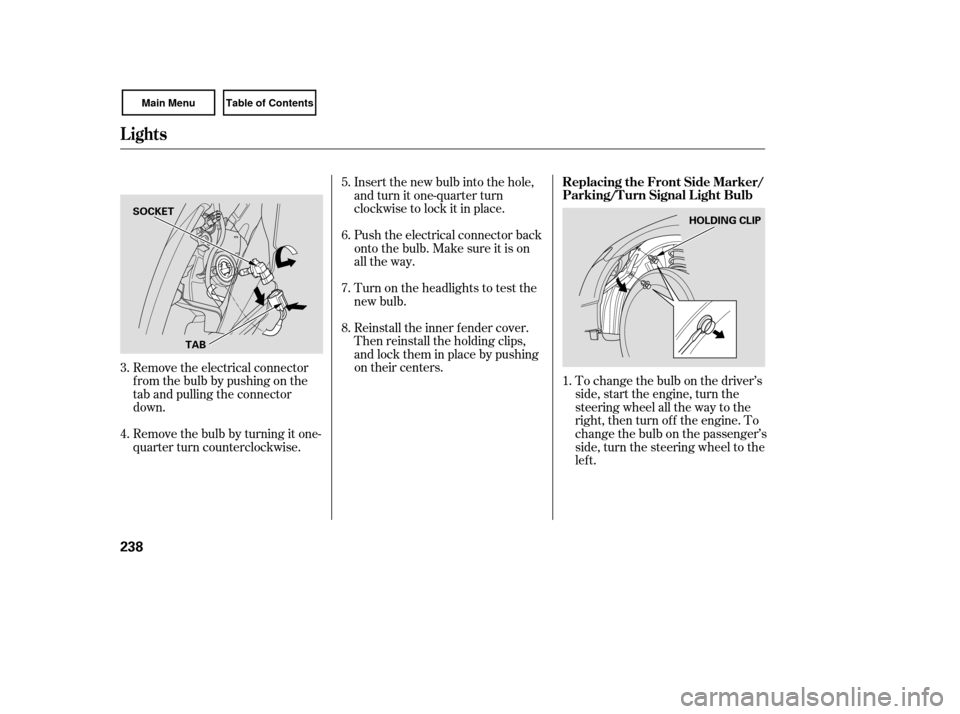
To change the bulb on the driver’s
side, start the engine, turn the
steering wheel all the way to the
right, then turn off the engine. To
change the bulb on the passenger’s
side, turn the steering wheel to the
lef t.
Reinstall the inner f ender cover.
Then reinstall the holding clips,
andlocktheminplacebypushing
on their centers. Insert the new bulb into the hole,
and turn it one-quarter turn
clockwise to lock it in place.
Push the electrical connector back
onto the bulb. Make sure it is on
all the way.
Turn on the headlights to test the
new bulb.
Remove the electrical connector
f rom the bulb by pushing on the
tab and pulling the connector
down.
Remove the bulb by turning it one-
quarter turn counterclockwise. 5.
6.
1.
7.
8.
3.
4.
Lights
Replacing the Front Side Marker/
Parking/Turn Signal Light Bulb
238
TAB HOLDING CLIP
SOCKET
Page 242 of 311
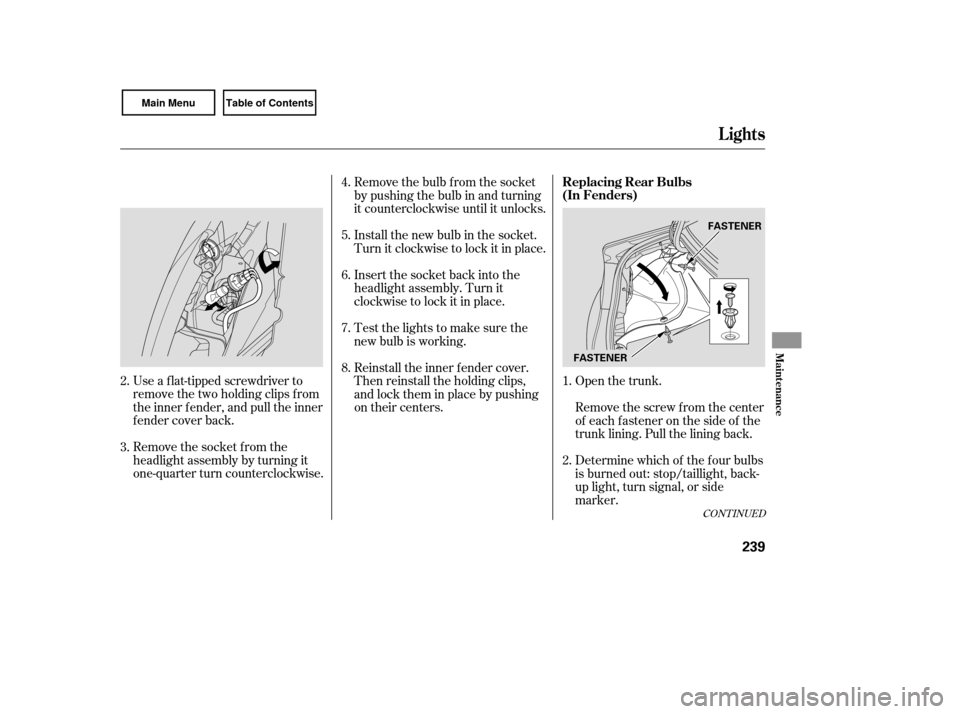
Open the trunk.
Remove the socket from the
headlight assembly by turning it
one-quarter turn counterclockwise. Use a f lat-tipped screwdriver to
remove the two holding clips f rom
the inner f ender, and pull the inner
f ender cover back. Remove the bulb f rom the socket
by pushing the bulb in and turning
it counterclockwise until it unlocks.
Remove the screw from the center
of each f astener on the side of the
trunk lining. Pull the lining back.
Determine which of the f our bulbs
is burned out: stop/taillight, back-
up light, turn signal, or side
marker.
Install the new bulb in the socket.
Turn it clockwise to lock it in place.
Insert the socket back into the
headlight assembly. Turn it
clockwise to lock it in place.
Test the lights to make sure the
new bulb is working.
Reinstall the inner f ender cover.
Then reinstall the holding clips,
andlocktheminplacebypushing
on their centers.
1.
4.
5.
6.
7.
8.
3. 2. 2.
CONT INUED
Replacing Rear Bulbs
(In Fenders)
Lights
Maint enance
239
FASTENERFASTENER
Page 243 of 311
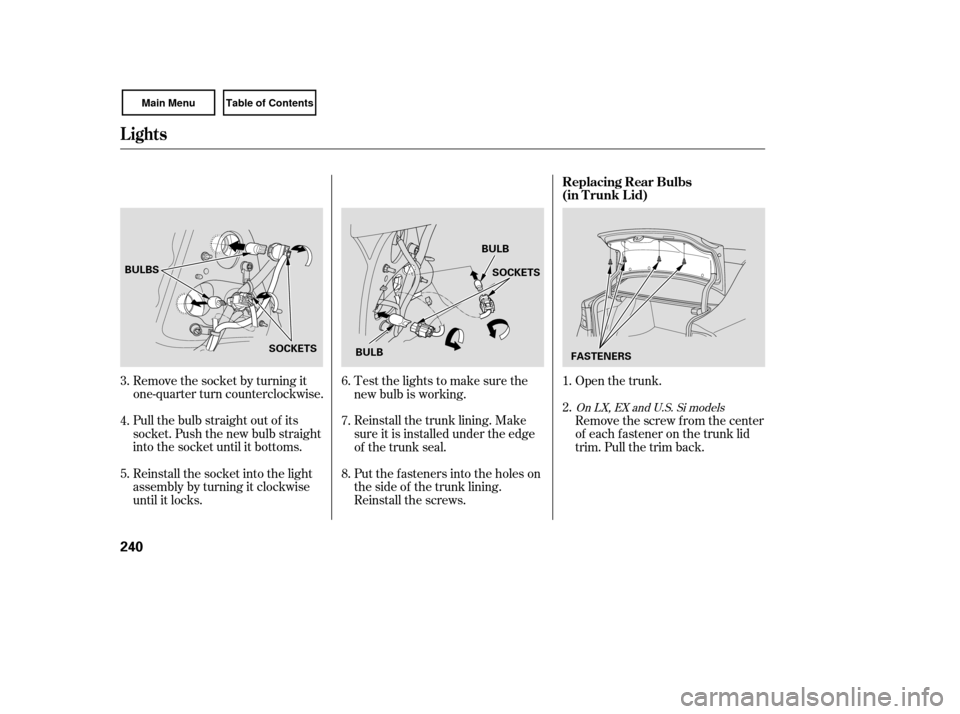
Open the trunk.
Remove the socket by turning it
one-quarter turn counterclockwise.
Pull the bulb straight out of its
socket. Push the new bulb straight
into the socket until it bottoms.
Reinstall the socket into the light
assembly by turning it clockwise
until it locks. Put the f asteners into the holes on
the side of the trunk lining.
Reinstall the screws. Reinstall the trunk lining. Make
sure it is installed under the edge
of the trunk seal. Test the lights to make sure the
new bulb is working.
Remove the screw from the center
of each f astener on the trunk lid
trim. Pull the trim back.
1.
2.
4.
5. 6.
7.
8.
3.
On LX, EX and U.S. Si models
Lights
Replacing Rear Bulbs
(in T runk L id)
240
BULBS
SOCKETS SOCKETS
BULB
BULB FASTENERS
Page 244 of 311
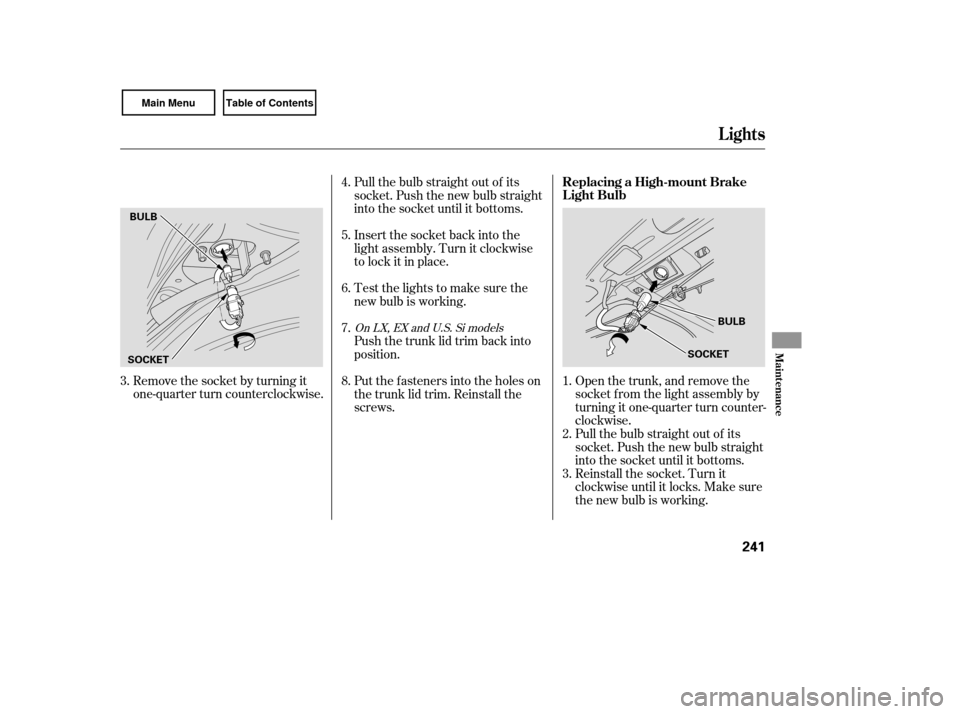
Remove the socket by turning it
one-quarter turn counterclockwise.Open the trunk, and remove the
socket f rom the light assembly by
turning it one-quarter turn counter-
clockwise.
Pull the bulb straight out of its
socket. Push the new bulb straight
into the socket until it bottoms.
Reinstall the socket. Turn it
clockwise until it locks. Make sure
the new bulb is working.
Pull the bulb straight out of its
socket. Push the new bulb straight
into the socket until it bottoms.
Insert the socket back into the
light assembly. Turn it clockwise
to lock it in place.
Test the lights to make sure the
new bulb is working.
Push the trunk lid trim back into
position.
Put the f asteners into the holes on
the trunk lid trim. Reinstall the
screws.
2. 1.
3.
4.
5.
6.
7.
8.
3.
On LX, EX and U.S. Si models
Lights
Replacing a High-mount Brake
Light Bulb
Maint enance
241
BULB
SOCKET
BULB
SOCKET
Page 245 of 311
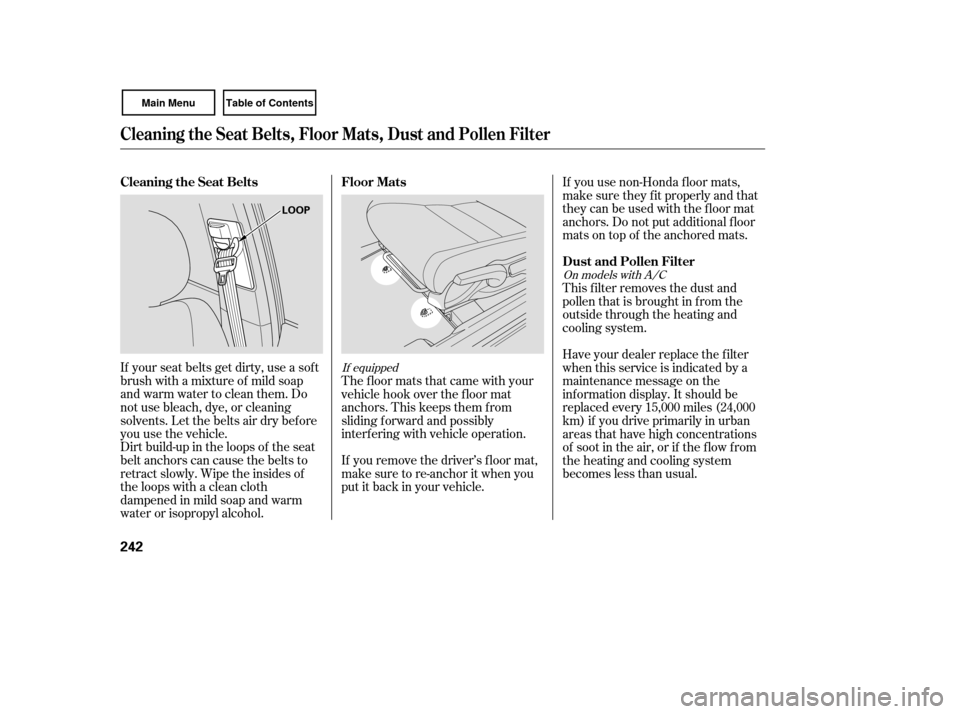
Dirt build-up in the loops of the seat
belt anchors can cause the belts to
retract slowly. Wipe the insides of
the loops with a clean cloth
dampened in mild soap and warm
water or isopropyl alcohol.This f ilter removes the dust and
pollenthatisbroughtinfromthe
outside through the heating and
cooling system.
If your seat belts get dirty, use a sof t
brush with a mixture of mild soap
and warm water to clean them. Do
not use bleach, dye, or cleaning
solvents. Let the belts air dry bef ore
you use the vehicle. The floor mats that came with your
vehicle hook over the f loor mat
anchors. This keeps them f rom
sliding f orward and possibly
interf ering with vehicle operation.
If you remove the driver’s f loor mat,
make sure to re-anchor it when you
putitbackinyourvehicle.If you use non-Honda f loor mats,
make sure they f it properly and that
theycanbeusedwiththefloormat
anchors. Do not put additional f loor
mats on top of the anchored mats.
Have your dealer replace the filter
when this service is indicated by a
maintenance message on the
inf ormation display. It should be
replaced every 15,000 miles (24,000
km) if you drive primarily in urban
areas that have high concentrations
of soot in the air, or if the f low f rom
the heating and cooling system
becomeslessthanusual.
If equipped
On models with A/C
Floor Mats
Dust and Pollen Filter
Cleaning the Seat Belts
Cleaning the Seat Belts, Floor Mats, Dust and Pollen Filter
242
LOOP
Page 246 of 311
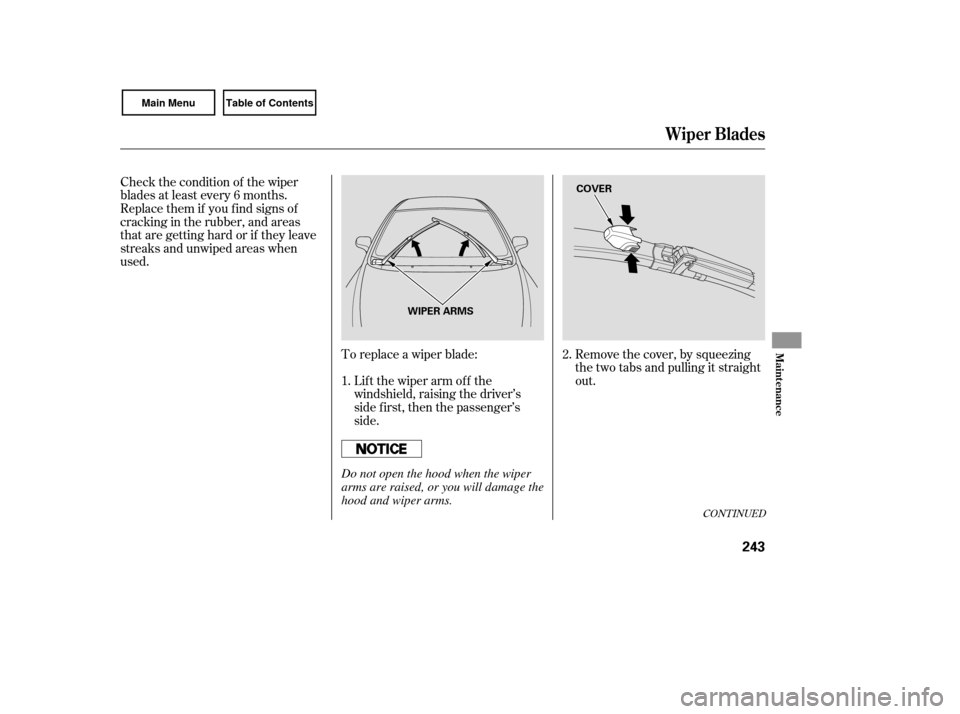
Check the condition of the wiper
blades at least every 6 months.
Replace them if you f ind signs of
cracking in the rubber, and areas
that are getting hard or if they leave
streaks and unwiped areas when
used.To replace a wiper blade: Remove the cover, by squeezing the two tabs and pulling it straight
out.
Lift the wiper arm off the
windshield, raising the driver’s
side first, then the passenger’s
side. 2.
1.
CONT INUED
Wiper Blades
Maint enance
243
COVER
WIPER ARMS
Do not open the hood when the wiper
arms are raised, or you will damage the
hood and wiper arms.
Page 247 of 311
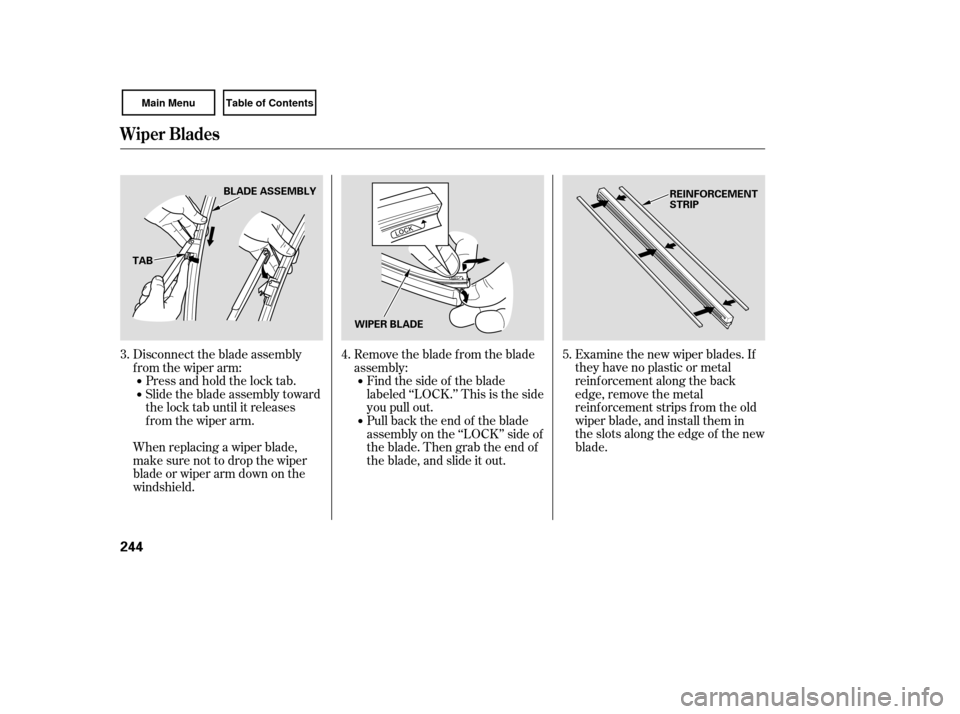
Examine the new wiper blades. If
they have no plastic or metal
reinf orcement along the back
edge, remove the metal
reinf orcement strips f rom the old
wiper blade, and install them in
the slots along the edge of the new
blade.
Disconnect the blade assembly
from the wiper arm:
Press and hold the lock tab.
Slide the blade assembly toward
the lock tab until it releases
from the wiper arm.
When replacing a wiper blade,
make sure not to drop the wiper
blade or wiper arm down on the
windshield. Remove the blade from the blade
assembly:
Findthesideof theblade
labeled ‘‘LOCK.’’ This is the side
you pull out.
Pull back the end of the blade
assembly on the ‘‘LOCK’’ side of
theblade.Thengrabtheendof
the blade, and slide it out.
3. 4. 5.
Wiper Blades
244
BLADE ASSEMBLY
TAB WIPER BLADE REINFORCEMENT
STRIP
Page 248 of 311
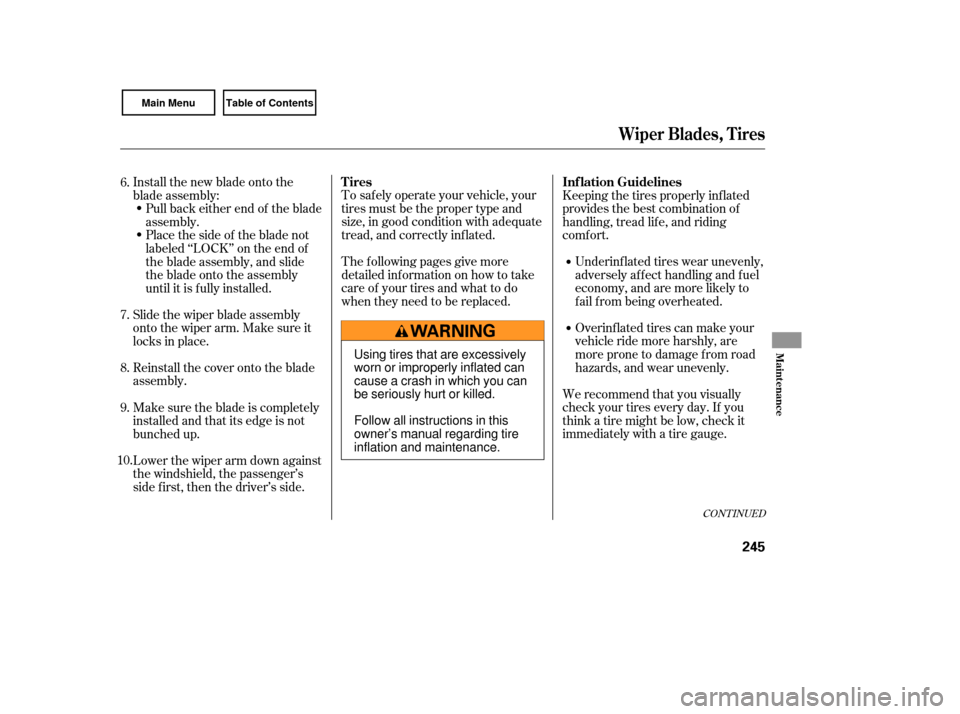
To saf ely operate your vehicle, your
tires must be the proper type and
size, in good condition with adequate
tread, and correctly inf lated.
The f ollowing pages give more
detailed inf ormation on how to take
care of your tires and what to do
when they need to be replaced.Keeping the tires properly inf lated
provides the best combination of
handling, tread lif e, and riding
comf ort.
Underinf lated tires wear unevenly,
adversely affect handling and fuel
economy, and are more likely to
fail from being overheated.
Overinf lated tires can make your
vehicleridemoreharshly,are
more prone to damage f rom road
hazards, and wear unevenly.
We recommend that you visually
check your tires every day. If you
think a tire might be low, check it
immediately with a tire gauge.
Install the new blade onto the
blade assembly:
Pull back either end of the blade
assembly.
Place the side of the blade not
labeled‘‘LOCK’’ontheendof
the blade assembly, and slide
the blade onto the assembly
until it is f ully installed.
Slide the wiper blade assembly
onto the wiper arm. Make sure it
locks in place.
Reinstall the cover onto the blade
assembly.
Lower the wiper arm down against
the windshield, the passenger’s
side first, then the driver’s side. Make sure the blade is completely
installed and that its edge is not
bunched up.
6.
7.
8.
9.
10.
CONT INUED
Wiper Blades, Tires
T ires Inf lation Guidelines
Maint enance
245
Using tires that are excessively
worn or improperly inflated can
cause a crash in which you can
be seriously hurt or killed.
Follow all instructions in this
owner’s manual regarding tire
inflation and maintenance.
Page 249 of 311
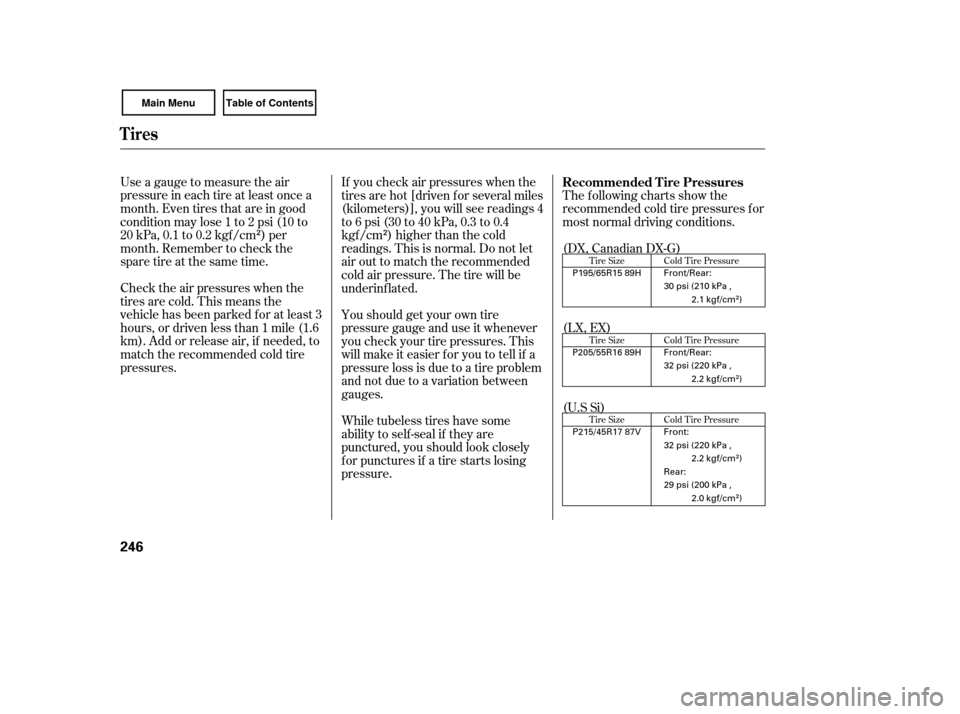
Tire Size
Tire SizeCold Tire Pressure
Tire Size Cold Tire Pressure Cold Tire Pressure
Use a gauge to measure the air
pressure in each tire at least once a
month. Even tires that are in good
condition may lose 1 to 2 psi (10 to
20 kPa, 0.1 to 0.2 kgf /cm ) per
month. Remember to check the
sparetireatthesametime.
The following charts show the
recommended cold tire pressures f or
most normal driving conditions.
Check the air pressures when the
tires are cold. This means the
vehicle has been parked f or at least 3
hours, or driven less than 1 mile (1.6
km). Add or release air, if needed, to
match the recommended cold tire
pressures. If you check air pressures when the
tires are hot [driven f or several miles
(kilometers)], you will see readings 4
to6psi(30to40kPa,0.3to0.4
kgf /cm ) higher than the cold
readings. This is normal. Do not let
air out to match the recommended
cold air pressure. The tire will be
underinf lated.
Youshouldgetyourowntire
pressure gauge and use it whenever
you check your tire pressures. This
will make it easier f or you to tell if a
pressure loss is due to a tire problem
and not due to a variation between
gauges.
While tubeless tires have some
ability to self -seal if they are
punctured, you should look closely
for punctures if a tire starts losing
pressure.
(LX, EX) (DX, Canadian DX-G)
(U.S Si) Recommended T ire Pressures
Tires
246
P195/65R15 89H
P205/55R16 89H
30 psi (210 kPa ,
2.1 kgf/cm
)
32 psi (220 kPa , 2.2 kgf/cm
)
P215/45R17 87V 32 psi (220 kPa ,2.2 kgf/cm
)
29 psi (200 kPa , 2.0 kgf/cm
)
Front:
Rear: Front/Rear:
Front/Rear:
Page 250 of 311
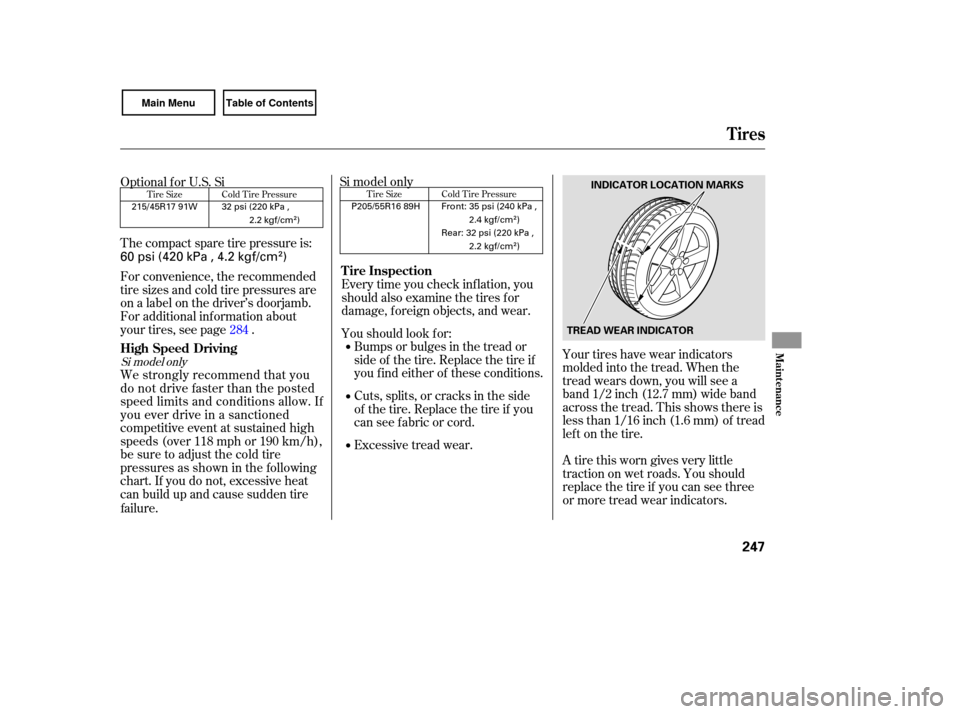
Your tires have wear indica tors
molded into the tread. When the
tread wears down, you will see a
band 1/2 inch (12.7 mm) wide band
across the tread. This shows there is
less than 1/16 inch (1.6 mm) of tread
left on the tire.
A tire this worn gives very little
traction on wet roads. You should
replace the tire if you can see three
or more tread wear indicators.
Bumps
or bulges in the tread or
side of the tire. Replace the tire if
youfindeitheroftheseconditions.
Cu ts, splits, or cracks in the side
of the tire. Replace the tire if you
can see fabric or cord.
Excessive tread wear.
Every
time you check inflation, you
should also examine the tires for
damage, foreign objects, and wear.
Youshouldlookfor:
Thecompactsparetirepressureis:
For
convenience, the recommended
tire sizes and cold tire pressures are
on a label on the driver’s doorjamb.
For additional inf ormation about
your tires, see page . Optional f or U.S. Si
284
Tire Size Cold Tire Pressure
Tires
Tire Inspection
Maint enance
247
TREAD WEAR INDICATORINDICATOR LOCATION MARKS
60 psi (420 kPa , 4.2 kgf/cm)
32 psi (220 kPa ,
2.2 kgf/cm
)
215/45R17 91W
competitive event at sustained high
speeds (over 118 mph or 190 km/h),
be sure to adjust the cold tire
pressures as shown in the following We strongly recommend that you
do not drive faster than the posted
speed limits and conditions allow. If
you ever drive in a sanctioned
Si model only
High Speed Driving
Tire Size Cold Tire Pressure
Front: 35 psi (240 kPa ,
2.4 kgf/cm
)
P205/55R16 89H
Rear: 32 psi (220 kPa ,
2.2 kgf/cm
)
Si model only
chart. If you do not, excessive heat
can build up and cause sudden tire
failure.